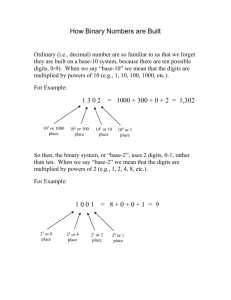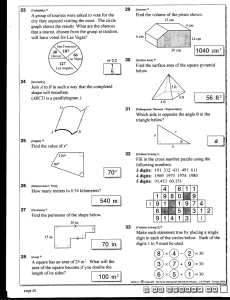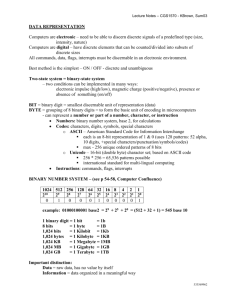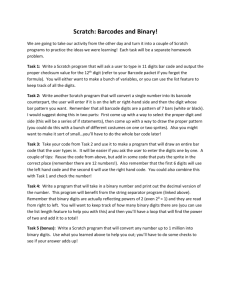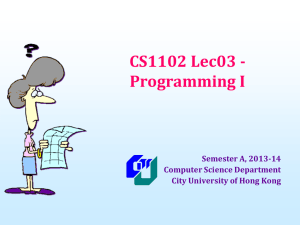Document 11444711
advertisement
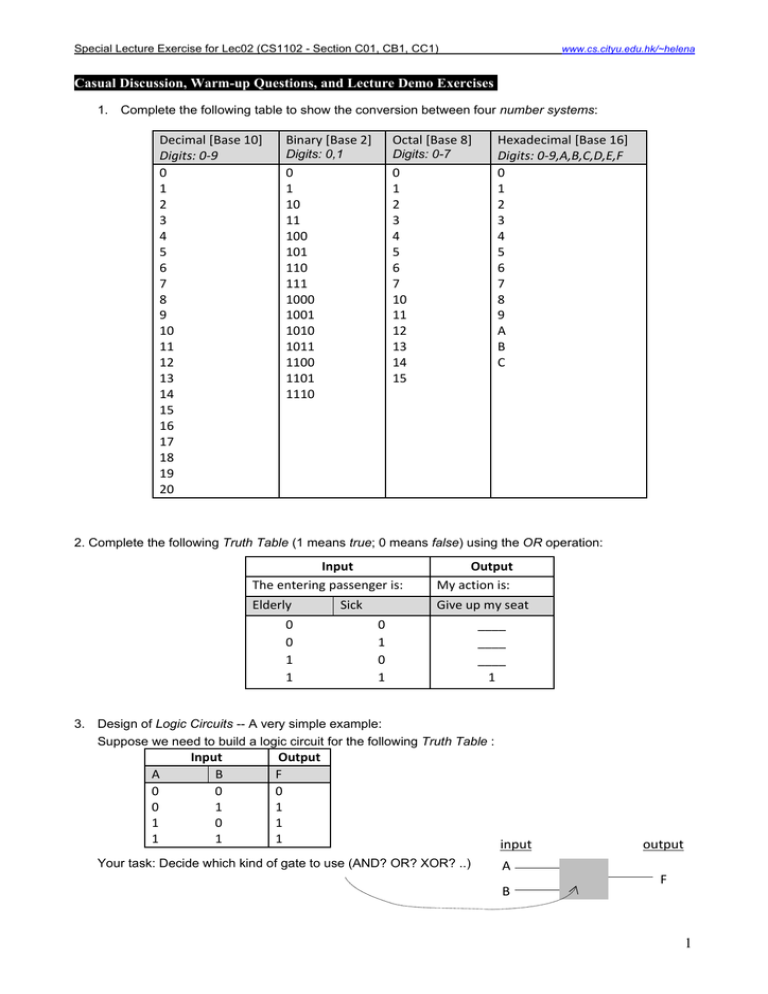
Special Lecture Exercise for Lec02 (CS1102 - Section C01, CB1, CC1) www.cs.cityu.edu.hk/~helena Casual Discussion, Warm-up Questions, and Lecture Demo Exercises 1. Complete the following table to show the conversion between four number systems: Decimal [Base 10] Digits: 0‐9 0 1 2 3 4 5 6 7 8 9 10 11 12 13 14 15 16 17 18 19 20 Binary [Base 2] Digits: 0,1 0 1 10 11 100 101 110 111 1000 1001 1010 1011 1100 1101 1110 Octal [Base 8] Digits: 0-7 0 1 2 3 4 5 6 7 10 11 12 13 14 15 Hexadecimal [Base 16] Digits: 0‐9,A,B,C,D,E,F 0 1 2 3 4 5 6 7 8 9 A B C 2. Complete the following Truth Table (1 means true; 0 means false) using the OR operation: Input The entering passenger is: Output My action is: Elderly Give up my seat 0 0 1 1 Sick 0 1 0 1 ____ ____ ____ 1 3. Design of Logic Circuits -- A very simple example: Suppose we need to build a logic circuit for the following Truth Table : A 0 0 1 1 Input B 0 1 0 1 Output F 0 1 1 1 Your task: Decide which kind of gate to use (AND? OR? XOR? ..) input output A B F 1 Special Lecture Exercise for Lec02 (CS1102 - Section C01, CB1, CC1) www.cs.cityu.edu.hk/~helena 4. (i) Complete the table on the right which shows the powers of 2: 20 21 22 23 24 25 26 27 28 29 210 (ii). Fill in the blanks: (a) 0 1 0 0 0 0 1 1 (2) = __________________(10) (b) 1 1 1 1 0 0 1 1 (2) = __________________(16) (c) 1 1 0 1 0 0 1 1 (2) = __________________(8) = 1 = 2 = 4 = 8 = = = = = = = 5. [Slide 6 -- explained] Why are followings most commonly used? Number System (Base 2) Binary - 2 digits: (Base 8) Octal - 8 digits: (Base 10) Decimal - 10 digits: (Base 16) Hexadecimal - 16 digits: Reason to use 0,1 0-7 0-9 0-9,A-F 6. [Slide 7 -- more] Choose "Least significant" or "Most significant" to describe each underlined digit: Note: significant means "important" I have $375.15 Most / least significant digit 7. [Slide 8 -- explained] (i) Complete the table on the right to show the negative powers of 2: (ii) Fill in the blank: 101.1001(2) = ___________(10) Most / least significant digit 20 = 1 2‐1 = 1 21 = 0.5 2‐2 = = 2‐3 = = 2‐4 = = 2 Special Lecture Exercise for Lec02 (CS1102 - Section C01, CB1, CC1) www.cs.cityu.edu.hk/~helena 8. Summary / More practices on Binary Arithmetic What you learn [Slide 8] Conversion from Binary to Decimal [Slide 9] Binary Addition (note: carry digits) [Slide 9] Binary Subtraction (note: borrow digits) [Slide 10] Binary Multiplication [Slide 10] Binary Division [Slide 11] Conversion from Decimal to Binary (Whole numbers) Repeated division [Slide 12] Conversion from Decimal to Binary (Fraction part) Repeated multiplication [Slide 13-14] To deal with -ve numbers Using Two's Complement More Examples, Practices (a) 101.1001(2) = ____________(10) (b) 0011(2) +0101(2) = ____________(2) (c) 1001(2) -0011(2) = ____________(2) (d) 101(2) x 110(2) = ____________(2) (e) 111000(2) / 110(2) = _____________(2) (f) 26(10) = _____________(2) (g) 0.6(10) = _____________(2) (h) 5 - 2 = _____________(2) 3 Special Lecture Exercise for Lec02 (CS1102 - Section C01, CB1, CC1) www.cs.cityu.edu.hk/~helena 9. Fill in the blanks: (i) Consider values >= 0 2 bits can represent ________ different values (00,01,10,11, ie. 0 to 3) 3 bits can represent ________ different values (000,001,010,011,100,101,110,111, ie. 0 to 7) 4 bits can represent ________ different values (0000,0001,...1111, ie. 0 to 15) ___ bits can represent 256 different values (00000000 to 11111111, ie. 0 to 255) (ii) Now consider using 2's complements to represent a range of -ve to + ve numbers [Slide #14] If we use 4 bits to represent a range of numbers in 2's complement, they can be -8(10) to 7(10) If we use 8 bits to represent a range of numbers in 2's complement, they can be -128(10) to ____(10) In 2's complement, The left-most bit is always __. (See slide #14) 10. [Slides 21-25] Draw the Truth Tables for the expressions: F = (A AND B) OR C F = A NAND B Input A B Output F A Input B C Output F Fill in the blanks for the following expressions, according to the given Truth Tables: F = A _____ ( B ____ C ) F = A _____ ( B ____ C ) Input Output A B C F 0 0 0 0 0 0 1 0 0 1 0 0 0 1 1 0 1 0 0 0 1 0 1 1 1 1 0 1 1 1 1 1 Input Output A B C F 0 0 0 0 0 0 1 0 0 1 0 0 0 1 1 0 1 0 0 1 1 0 1 1 1 1 0 1 1 1 1 0 12. [Slide 28] Explain the steps to calculate 1 1 0 1 + 0 1 0 1 Ref: 4-bit full-adder 4 Special Lecture Exercise for Lec02 (CS1102 - Section C01, CB1, CC1) www.cs.cityu.edu.hk/~helena [From slides 22-24] 5

